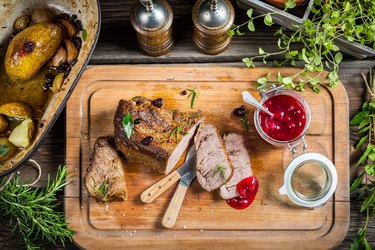
A slow cooker venison roast can be tender and flavorful. Deer meat benefits greatly from a low, slow cooking process, and a slow cooker helps to remove some of the deer meat's natural toughness and gamey flavor. Read on to learn how to prepare a deer roast for the Crock Pot.
Deer Roast Crock Pot Tips
Video of the Day
Deer meat is naturally tougher than beef, chicken and other domesticated meat. Also, because of the deer's diet, venison tends to have a gamey flavor that not everyone enjoys. Fortunately, you can take steps to prevent the meat from getting too tough or having a gamey flavor.
Video of the Day
The University of Minnesota provides some helpful tips for preparing deer meat, which will help tenderize the meat and help remove the gamey flavor. Some steps you should take in preparing the deer roast for the crock pot include:
tenderize the meat with a tenderizer before marinating
serve the venison very hot or very cold
—
this helps to prevent the gamey flavor from coming out too much
use fats such as olive oil or butter when cooking
—
this helps to prevent the meat from getting too tough
use a marinade to add flavor and help tenderize the meat
remove any remaining hairs from the meat
— use a vinegar-soaked cloth to remove hairs
use strong spices and herbs to help mask the flavor, such as rosemary or thyme
One advantage of a slow cooker venison roast is that the cooking temperature will be low. If you cook deer meat at a high temperature, you are more likely to create a tough, rubbery end result. A slow cooker helps prevent the venison from getting too tough during the cooking process, which should create a very tender end result.
Slow Cooker Deer Roast Recipe
A good deer roast recipe for the Crock Pot should include a marinade full of herbs and spices. A marinade does two things: it helps to draw out the gamey flavor of the meat, replacing it with additional flavors, and it also helps to tenderize the roast. You should choose a marinade that has an acidic component to it such as vinegar, buttermilk, wine or tomato-based sauces.
When you have selected your marinade, place the venison in a sealed bag or bowl after dredging it with the marinade. Place it in the refrigerator overnight.
One of the advantages of a slow cooker deer roast is that once the meat has finished marinating, you can place both it and the marinade in the slow cooker and let it cook all day. Prior to placing the roast in the slow cooker, you may want to add a fat like olive oil, as well as vegetables such as carrots or potatoes.
A venison roast needs to cook all day to reach the minimum safe temperature of 145 degrees Fahrenheit that the USDA recommends. In fact, a slow cooker will likely cook the roast to a well done state, which will help make the meat very tender.
Deer Meat Safety
When working with deer meat, you should follow standard food safety practices. According to the Centers for Disease Control and Prevention (CDC), the steps you should follow include:
- washing your hands and any surface the deer meat touches with warm water and soap
- keeping the deer meat separate from other ingredients until ready to cook
- refrigerating the cooked or raw meat until ready to serve
When hunting game, it is important to know that there is an added risk of infection from deer and other wild animals. The CDC warns hunters about the potential of coming in contact with brucellosis. Brucellosis is a bacterial infection that can cause symptoms such as fever, muscle aches, chills and fatigue.
To prevent infection, the CDC recommends that hunters avoid contact with visibly sick animals or animals found dead. Also, a hunter should practice safe game handling, including cleaning the deer properly, dressing the meat and wearing protective clothing to help prevent contamination.
- United States Department of Agriculture: "Safe Minimum Internal Temperature Chart"
- Center for Disease Control and Prevention: "Four Steps (Clean, Separate, Cook, Chill) to Food Safety"
- University of Minnesota: "Cooking Venison for Flavor and Safety"
- Centers for Disease Control and Prevention: "Hunters Risks"